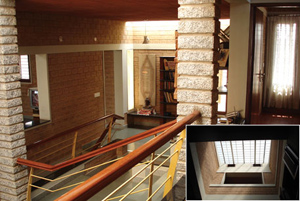
Most compressed earth blocks (CEBs) are made in a mechanical press with a mixture of sandy soil, clayey soil, and a small amount of cement and water. CEBs typically require no plaster and are popular for walls, privacy walls, planters and much more. We used CEBs on our outdoor kitchen and raised garden beds. Recently I’ve discovered some rather unusual and very interesting CEBs made with unconventional materials. In addition to the compressed blocks shown here, you could use crushed glass, lava rock, brightly colored soil in sediment-like layers, sea shells, crushed limestone and other low cost and sustainable materials. The main idea is to utilize what is affordable and locally available.
Laterite blocks
Laterite stone is ground, sieved, mixed with 5% cement and a setting agent, and pressed into blocks (mortarless interlocking blocks in thise case). I love the color.
Laterite blocks are specialty blocks and probably more expensive than conventionally CEBs. This could be an option for those who can afford it. They should be very durable and rainwater resistant since soft laterite turns as hard as brick when exposed to air. More information about laterite.
EcoBrick
Image source: EcoBrick

Fly ash is an industrial waste product, a residue of coal based power plants. Fly ash is often added to concrete to reduce the use of cement. Fly ash can also be compressed into strong, durable blocks. The stark gray color can be easily improved by adding natural mineral pigments such as iron oxide. More about fly ash blocks.
Image source: Alibaba.com

This house by Deepak Godhi in Bangalore, India uses CEBs made with sandstone chips. The rough stone texture is particularly appealing. The rough exposed aggregate surface may be created with a pressure washer. Columns like these are often made with hollow CEBs to make room for rebar and concrete reinforcement.
Image source: Down to Earth.org
Search our blog for more information. We have lots of information on CEBs.

Dear Geiger,
Delighted to see and hear about you and you work.I have always been fascinated by the production of cseb and going for a training next month at Auroville Earth institute on production and masonry in cseb.Recently I found in your blog about the designer ceb and the concept and aesthetics were awesome.Is it possible to produce blocks like those commercially using geopolymer binders.
Keep up the excellent work.
Regards
Dr.A.Venkatesh Perumal
Yes you can. This would be a niche market unless you came up with a popular design.
Hi am interested in building a house with compressed earth blocks please provide me with any additional information
Just keep reading and searching. Most everything you need is online — both here and on other sites.
i have a good question to ask ? Please can i add colour pigments to my laterite soil to produce compressed earth coloured bricks?
Yes. Make small samples and figure out how much you need.
In my experience, local power plants may or may not be interested in working with individuals seeking flyash. Some welcome you. Some shun you like you’re a leper.
For small quantities, it’s usually a lot easier to ask the local concrete mixing plant. They will be happy to sell you some.
For large quantities it is often worth the extra effort to acquire flyash direct from a power plant and avoid the costs of buying flyash through the middlemen.
Thanks Owen for your advice.
Do you make your CEBs, or buy them? If you make them, where do you get the press? If you buy them, where?
Thanks!
I’m just reporting on some interesting CEB options. I’m not making any CEBs at this time. You’ll have to do more research and decide whether it makes more sense to buy them or make them. Is there a big supplier in your area who sells CEBs are low cost? If so, then it might make sense to just buy them. Transportation cost is big. Always try to buy local.
Two questions. Where would you buy fly ash? Can you build your own press? If you can, what’s involved in building one?
Contact local power plants for fly ash. There are plans on the Internet, although I believe the best quality machines are sold by a few companies. Search our blog for more about CEB presses. Auroville presses have a good reputation.